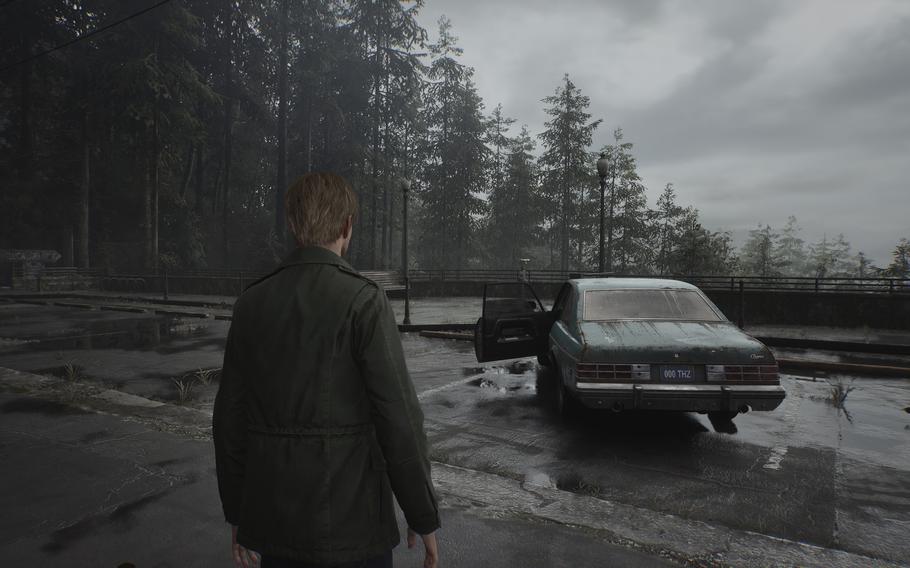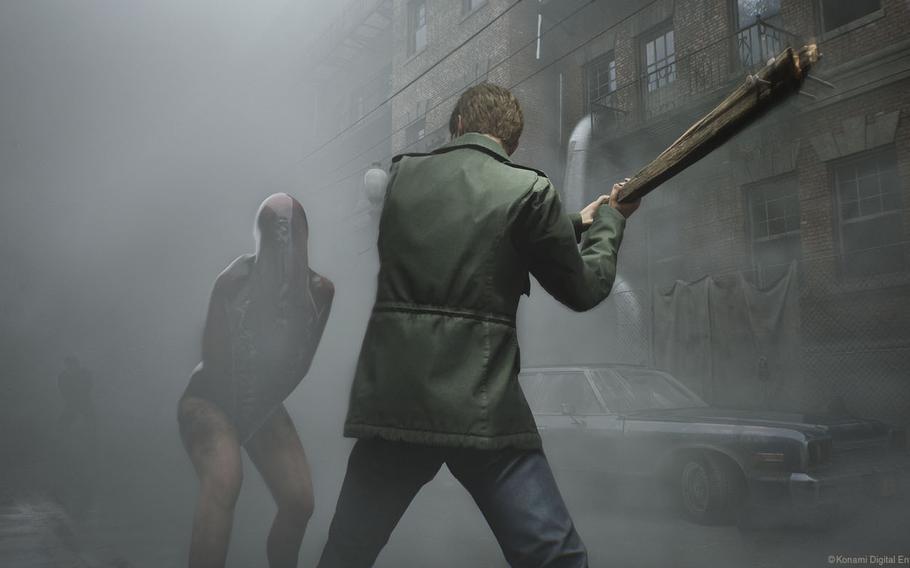
A mysterious and dangerous town in the remake of Silent Hill 2. (Konami Digital Entertainment)
“There was a hole here. It’s gone now.”
The meaning of the words, a blood-red message spray-painted on a covered window in a deserted bar, has long been debated by fans of Konami’s 2001 seminal psychological survival horror game Silent Hill 2. More than two decades later, we’re no closer to understanding those unnerving words, but the release of the remake does frame them in a new light.
The original Silent Hill 2 is, simply put, a masterpiece. A brilliant and nightmarish symphony of grief, trauma, loss, resilience and possible redemption, the PlayStation 2-era release is the type of game that leaves a mark on your psyche. Yes, there’s combat to fight and puzzles to solve, but what sticks with you is the story of an ordinary man clawing through the depths of his own hell, chained to his own regrets and fears, and seeing only the dimmest of lights at the end of the tunnel. It’s not a pleasant journey; then again, it was inspired by Dostoevsky’s “Crime and Punishment.”
The remake, developed by Bloober Team (Layers of Fear, The Medium) and published by Konami, sticks to the same basic story: Protagonist James Sunderland (voiced by Luke Roberts) returns to the lake town of Silent Hill after receiving a letter from his wife, Mary (voiced by Salóme Gunnarsdóttir). The issue? Mary died from a terminal disease three years earlier. What follows is James’ nightmare journey through Silent Hill, a place once special to the two of them that’s now overrun by horrid creatures, oppressive fog and physical manifestations of grief and guilt — some of them armed with knives.
Trauma and its resulting effects continue to play center stage in the remake. It’s not the actual monsters James has to fight that cause the most damage — it’s the places that remind James of Mary, before the pain and fear of death made her lash out; it’s every time James is reminded of his own bitterness toward Mary; it’s in a letter sent from a dead wife and a picture of her that James carries with him. You won’t finish Silent Hill 2 without feeling unmoored. (The game has eight endings depending on certain criteria; five of them can only be obtained in subsequent playthroughs.)
Utilizing Unreal Engine 5, the remake is a dazzling display of detail. From the first scene — a stunning close-up of James, first his hands and then his face — to the fleshed-out locations you travel through to the enemies in your way, Silent Hill 2 is a visual showstopper. The game also isn’t afraid to play with lighting as it bounces between white, black and myriad splashes of red.
All of that pairs quite nicely with the phenomenal audio and level design. Many enemy-less sequences feel even scarier because of the score by Akira Yamaoka (who was also composer for the 2001 game). And though the remake is quite a bit longer than the original (about 15 hours if you’re exploring most of each area, compared to about eight for the original), each expanded level cleverly loops into itself, creating ingenious ways of moving you forward all in one confined space.

In the remake of Silent Hill 2, the town is now overrun by horrid creatures, oppressive fog and physical manifestations of grief and guilt — some of them armed with knives. (Konami Digital Entertainment)
Combat also gets a major upgrade, which takes inspiration from the modern Resident Evil and Dead Space games. The camera is now over-the-shoulder instead of cinematically fixed for the most part, allowing more control of your own field of vision. ( Whether that’s everyone’s cup of tea is up for debate. ) Weapons can be swapped on the fly instead of you needing to go into the menu. And every encounter feels more physical, more meaty, because of how close the camera gets to the enemy. (Enemies are plentiful here, but the game is also really generous with ammo and healing items.)
All that being said, 2001’s Silent Hill 2 was also known for just being weird, almost charmingly so, mostly because of the incredibly stilted and awkward dialogue by the game’s amateur voice cast. The remake discards that oddness for a deeper sense of realism, particularly when it comes to James and his dialogue delivery. (In the original, he came off as blunt and cold; in the remake, he’s distraught and panicked.) But in doing so, the remake loses a bit of something essential: personality. Much like that hole, it’s gone now. It’s a rare case of something being too good.
In the end, Bloober Team’s remake of Silent Hill 2 does just about everything right: It hews to the affecting story of the original but modernizes everything from the visuals to the combat, all to much success. It might be a bit too polished in certain situations and perhaps a touch too long, but it’s a fantastic addition to the Silent Hill franchise and a perfect reason to visit (or return to) this broken little town.
Platforms: PC, PlayStation 5
Online: konami.com/games/silenthill/2r